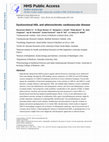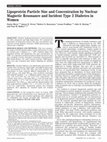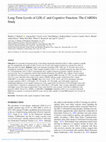Papers by Robert Rosenson

Nature Reviews Cardiology, Sep 1, 2015
High-density lipoproteins (HDLs) protect against atherosclerosis by removing excess cholesterol f... more High-density lipoproteins (HDLs) protect against atherosclerosis by removing excess cholesterol from macrophages through the ATP-binding cassette transporter A1 (ABCA1) and ATP-binding cassette transporter G1 (ABCG1) pathways involved in reverse cholesterol transport. Factors that impair the availability of functional apolipoproteins or the activities of ABCA1 and ABCG1 could, therefore, strongly influence atherogenesis. HDL also inhibits lipid oxidation, restores endothelial function, exerts anti-inflammatory and antiapoptotic actions, and exerts anti-inflammatory actions in animal models. Such properties could contribute considerably to the capacity of HDL to inhibit atherosclerosis. Systemic and vascular inflammation has been proposed to convert HDL to a dysfunctional form that has impaired antiatherogenic effects. A loss of anti-inflammatory and antioxidative proteins, perhaps in combination with a gain of proinflammatory proteins, might be another important component in rendering HDL dysfunctional. The proinflammatory enzyme myeloperoxidase induces both oxidative modification and nitrosylation of specific residues on plasma and arterial apolipoprotein A-I to render HDL dysfunctional, which results in impaired ABCA1 macrophage transport, the activation of inflammatory pathways, and an increased risk of coronary artery disease. Understanding the features of dysfunctional HDL or apolipoprotein A-I in clinical practice might lead to new diagnostic and therapeutic approaches to atherosclerosis.
Cardiovascular Drugs and Therapy, Feb 1, 2015
Circulation Research, Jun 6, 2014
LDL-C is a negative acute phase reactant that was shown to fall by a maximum of 50% at 7 days aft... more LDL-C is a negative acute phase reactant that was shown to fall by a maximum of 50% at 7 days after an acute myocardial infarction (MI) in an era before therapies that limit infarct size were known or widely used. 1 The magnitude of reduction in LDL-C was in proportion to the myocardial injury and inflammatory response after an acute coronary syndrome (ACS). Similar observations were seen in the Myocardial Ischemia Reduction with Aggressive Cholesterol Lowering

Diabetes, Feb 25, 2010
OBJECTIVE-Diabetic dyslipoproteinemia is characterized by low HDL cholesterol and high triglyceri... more OBJECTIVE-Diabetic dyslipoproteinemia is characterized by low HDL cholesterol and high triglycerides. We examined the association of lipoprotein particle size and concentration measured by nuclear magnetic resonance (NMR) spectroscopy with clinical type 2 diabetes. RESEARCH DESIGN AND METHODS-This was a prospective study of 26,836 initially healthy women followed for 13 years for incident type 2 diabetes (n ϭ 1,687). Baseline lipids were measured directly and lipoprotein size and concentration by NMR. Cox regression models included nonlipid risk factors (age, race, smoking, exercise, education, menopause, blood pressure, BMI, family history, A1C, and C-reactive protein). NMR lipoproteins were also examined after further adjusting for standard lipids. RESULTS-Incident diabetes was significantly associated with baseline HDL cholesterol, triglycerides, and NMR-measured size and concentration of LDL, IDL, HDL, and VLDL particles. The associations of these particles differed substantially by size. Small LDL NMR and small HDL NMR were positively associated with diabetes (quintile 5 vs. 1 [adjusted hazard ratios and 95% CIs], 4.04 [3.21-5.09] and 1.84 [1.54-2.19], respectively). By contrast, large LDL NMR and large HDL NMR were inversely associated (quintile 1 vs. 5, 2.50 [2.12-2.95] and 4.51 [3.68-5.52], respectively). For VLDL NMR , large particles imparted higher risk than small particles (quintile 5 vs. 1, 3.11 [2.35-4.11] and 1.31 [1.10-1.55], respectively). Lipoprotein particle size remained significant after adjusting for standard lipids and nonlipid factors. CONCLUSIONS-In this prospective study of women, NMR lipoprotein size and concentrations were associated with incident type 2 diabetes and remained significant after adjustment for established risk factors, including HDL cholesterol and triglycerides.
Carolina Digital Repository (University of North Carolina at Chapel Hill), 2010
Cardiovascular Drugs and Therapy, Aug 6, 2016

Journal of The International Neuropsychological Society, Feb 10, 2021
Objectives: It is uncertain if long-term levels of low-density lipoprotein-cholesterol (LDL-C) af... more Objectives: It is uncertain if long-term levels of low-density lipoprotein-cholesterol (LDL-C) affect cognition in middle age. We examined the association of LDL-C levels over 25 years with cognitive function in a prospective cohort of black and white US adults. Methods: Lipids were measured at baseline (1985-1986; age: 18-30 years) and at serial examinations conducted over 25 years. Time-averaged cumulative LDL-C was calculated using the area under the curve for 3,328 participants with ≥3 LDL-C measurements and a cognitive function assessment. Cognitive function was assessed at the Year 25 examination with the Digit Symbol Substitution Test [DSST], Rey Auditory Visual Learning Test [RAVLT], and Stroop Test. A brain magnetic resonance imaging (MRI) sub-study (N = 707) was also completed at Year 25 to assess abnormal white matter tissue volume (AWMV) and gray matter cerebral blood flow volume (GM-CBFV) as secondary outcomes. Results: There were 15.6%, 32.9%, 28.9%, and 22.6% participants with timeaveraged cumulative LDL-C <100 mg/dL, 101-129 mg/dL, 130-159 mg/dL, and ≥160 mg/dL, respectively. Standardized differences in all cognitive function test scores ranged from 0.16 SD lower to 0.09 SD higher across timeaveraged LDL-C categories in comparison to those with LDL-C < 100 mg/dL. After covariate adjustment, participants with higher versus lower time-averaged LDL-C had a lower RAVLT score (p-trend = 0.02) but no differences were present for DSST, Stroop Test, AWMV, or GM-CBFV. Conclusion: Cumulative LDL-C was associated with small differences in memory, as assessed by RAVLT scores, but not other cognitive or brain MRI measures over 25 years of follow-up.
Journal of Clinical Lipidology
American Heart Journal Plus: Cardiology Research and Practice
American Heart Journal Plus: Cardiology Research and Practice, 2022
JACC. Ediçao em potugués, Nov 1, 2018

Circulation, 2015
Introduction: PCSK9 loss-of-function variants are associated with reduced low-density lipoprotein... more Introduction: PCSK9 loss-of-function variants are associated with reduced low-density lipoprotein cholesterol (LDL-C) concentrations. Genetic association studies of PCSK9 loss-of-function variants allow for the examination of the effects of lifetime low LDL-C on cardiovascular outcomes. Hypothesis: PCSK9 loss-of-function variants are associated with lower concentrations of LDL-C and reduced risk of coronary heart disease (CHD) and stroke. Methods: We studied the association of PCSK9 loss-of-function Y142X and C679X nonsense variants (n=366; 2.1%) in 17,459 African Americans (AAs) and R46L missense variants (n=962; 3.1%) in 31,469 whites with LDL-C, CHD and stroke in the US-based REasons for Geographic And Racial Difference in Stroke (REGARDS) study and 8 cohorts in the Cohorts for Heart and Aging Research in Genomic Epidemiology (CHARGE) Consortium. We combined multivariable adjusted differences in LDL-C between participants with and without PCSK9 variants across studies using inver...
Circulation, 2018
Background: Studies from the early 2000s have shown that people living with human immunodeficienc... more Background: Studies from the early 2000s have shown that people living with human immunodeficiency virus (HIV) have a higher risk of atherosclerotic cardiovascular disease (CVD) compared to those w...
Circulation, 2016
Introduction: The 2013 ACC/AHA cholesterol guideline recommends use of moderate- or high-intensit... more Introduction: The 2013 ACC/AHA cholesterol guideline recommends use of moderate- or high-intensity statins to reduce LDL-C and the risk of CVD events in high-risk groups. Meta-analyses of general p...

Cardiovascular Drugs and Therapy, 2021
Adults with atherosclerotic cardiovascular disease (ASCVD) are recommended high-intensity statins... more Adults with atherosclerotic cardiovascular disease (ASCVD) are recommended high-intensity statins, with those at very high risk for recurrent events recommended adding ezetimibe and/or a proprotein convertase subtilisin/kexin type 9 inhibitor if their low-density lipoprotein cholesterol (LDL-C) is ≥70 mg/dL. We estimated the number of recurrent ASCVD events potentially averted if all adults in the United States (US) ≥45 years of age with ASCVD achieved an LDL-C <70 mg/dL. The number of US adults with ASCVD and LDL-C ≥70 mg/dL was estimated from the National Health and Nutrition Examination Survey 2009–2016 (n = 596). The 10-year cumulative incidence of recurrent ASCVD events was estimated from the REasons for Geographic And Racial Differences in Stroke study (n = 5390), weighted to the US population by age, race, and sex. The ASCVD risk reduction by achieving an LDL-C <70 mg/dL was estimated from meta-analyses of lipid-lowering treatment trials. Overall, 14.7 (95% CI, 13.7–15.8) million US adults had ASCVD, of whom 11.6 (95% CI, 10.6–12.5) million had LDL-C ≥70 mg/dL. The 10-year cumulative incidence of ASCVD events was 24.3% (95% CI, 23.2–25.6%). We projected that 2.823 (95% CI, 2.543–3.091) million ASCVD events would occur over 10 years among US adults with ASCVD and LDL-C ≥70 mg/dL. Overall, 0.634 (95% CI, 0.542–0.737) million ASCVD events could potentially be averted if all US adults with ASCVD achieved and maintained LDL-C <70 mg/dL. A substantial number of recurrent ASCVD events could be averted over 10 years if all US adults with ASCVD achieved, and maintained, an LDL-C <70 mg/dL.

BACKGROUND Dyslipoproteinemias can be classified by their distinct lipoprotein patterns, which he... more BACKGROUND Dyslipoproteinemias can be classified by their distinct lipoprotein patterns, which helps determine atherosclerotic cardiovascular disease (ASCVD) risk and directs lipid management but this has required advanced laboratory testing. OBJECTIVE To develop a new algorithm for classifying lipoprotein disorders that only relies on the standard lipid panel. METHODS Lipid thresholds for defining the different lipoprotein phenotypes were derived for Non-High-Density Lipoprotein-Cholesterol (NonHDL-C) and Triglycerides (TG) to be concordant when possible with the current US Multi-Society guidelines for blood cholesterol management. RESULTS The new classification method categorizes patients into all the classical Fredrickson-like phenotypes except for Type III dysbetalipoproteinemia. In addition, a new hypolipidemic phenotype (Type VI) due to genetic mutations in apoB-metabolism is described. The validity of the new algorithm was confirmed by lipid analysis by NMR (N = 11,365) and b...

Diabetes, 2020
Due to emerging evidence, recent practice guidelines are emphasizing more aggressive use of effec... more Due to emerging evidence, recent practice guidelines are emphasizing more aggressive use of effective prevention strategies in high-risk patients with diabetes (DM). We assessed changes in the use of evidence-based therapies among pts with DM from a registry of 5006 U.S. participants (pts) with ASCVD and LDL-C ≥70mg/dL across 120 U.S. centers taking lipid-lowering therapy (LLT). Among 1,622 DM pts with 12-month follow-up, 14% had intensification of LLT since baseline, 7% de-escalated. Median LDL-C at 12 months was 81 mg/dL, an 11% decrease from baseline. Among pts in the LDL-C cohorts, the percentage with LDL-C <70mg/dL increased from baseline through 12 months (Table). Use of statins and high-intensity statins was stable, while ezetimibe increased, and PCSK9i’s were initiated in 3% of pts not on a PCSK9i at enrollment. Use of SGLT2i, GLP-1RA’s, and fish oil did not change. At 12 months, 8% were on all guideline-recommended therapies for optimal risk reduction, similar to 7% at b...

Journal of the American College of Cardiology, 2020
Background: The 2018 AHA/ACC cholesterol guideline considers adults with a history of ≥2 atherosc... more Background: The 2018 AHA/ACC cholesterol guideline considers adults with a history of ≥2 atherosclerotic cardiovascular disease (ASCVD) events as being at very high risk for future events. We compared the risk for ASCVD events following a myocardial infarction (MI) among patients with a prior history of ASCVD, chronic kidney disease (CKD) and diabetes mellitus (DM). Methods: We studied adults ≥66 years old with Medicare health insurance who had an MI on or after January 1, 2014. Patients were grouped into 8 categories based on the presence of a prior history of ASCVD, DM and/or CKD and followed until December 31, 2017 for ASCVD events. ASCVD was defined as an MI, coronary revascularization, stroke, or peripheral artery disease event. Results: Among 380,071 patients discharged from the hospital following an MI, 20.8%, 9.8% and 3.4% had a prior history of ASCVD only, DM only and CKD only, respectively, and 3.4% had both DM and CKD but no prior history of ASCVD (Table). Compared to patients with no prior history of ASCVD, CKD or diabetes, the multivariable-adjusted hazard ratio (HR) for ASCVD events was 1.33 (95% CI 1.27-1.40), 1.41 (95% CI: 1.38-1.45) and 1.33 (95% CI: 1.29-1.37) among those with a history of ASCVD only, DM only and CKD only, respectively. Also, patients with CKD and DM but without prior ASCVD had a higher risk for ASCVD events than those without prior ASCVD, CKD, or diabetes (Table). Conclusion: Following an MI, adults with DM and/or CKD have a very high risk for ASCVD events regardless of a prior history of ASCVD.
European Heart Journal, 2017
with 30 RF patients. The CB group had fewer gaps in left PVs (CB 1.20±1.03 vs RF 1.97±1.10, p=0.0... more with 30 RF patients. The CB group had fewer gaps in left PVs (CB 1.20±1.03 vs RF 1.97±1.10, p=0.007), but there were no significant differences in gap length (CB 23.1±25.02 mm vs RF 32.4±24.8 mm, p=0.10). Globally, the groups did not differ in total gaps (CB 4.40±2.19 vs RF 5.13±2.24, p=0.21), gap length (CB 80.09±50.65 mm vs RF 88.93±61.39 mm, p=0.55), or NGL (CB 0.32±0.19 mm vs RF 0.35±0.24 mm, p=0.59); For both techniques, right PVs had a higher number of gaps, compared to left PVs: 3.18±1.59 vs 1.58±1.12 (p=0.01), respectively. Conclusion: CB had a fewer number of DE-CMR gaps in the left PV's as compared to RF. Both techniques had a higher number of gaps in right PVs than in left PVs.











Uploads
Papers by Robert Rosenson